人教版新目标初中英语九年级下册You’re supposed to shake hands说课稿7篇
-
- 页数:20页
- 字数:约 23397 字
- 大小:107.00KB
- 格式:.doc
- 版本:Office2016及以上版本
- 作者:Murphy
You’re supposed to shake hands说课稿7篇
You’re supposed to shakehands.Section A 说课稿
一、说课内容
我主要从以下几个方面进行说课:说教材分析,说教学目标,说教法、学法,说教学设计。
(一)Analysis of teaching materials(教材分析)

我说课的内容选自人教版新目标九年级英语的Unit12 的Section A部分。在八年级第四单元的基础上,继续巩固be supposed to do sth .本单元中心话题是讨论不同国家不同民族礼仪和风俗文化的差异,如初次见面的礼仪、餐桌礼仪等,并围绕礼仪这一话题展开。它让学生通过对一些国家风俗习惯和礼仪差异的学习,提高学生对文明生活的认识。并且“风俗习惯,文化礼仪”知识是中考常考的知识点,因此本单元在教材中比较重要。
(二)Analysis of Situation study(学情分析)
本课所教育的对象为普通的农村学生,由于所处环境而使其知识面相对较窄。希望能通过本课的实施引导学生帮助学生获取更多的知识。
(三)Teaching Aims(教学目标)
1.Knowledgeaim(语言知识目标):
认知并掌握有关礼仪的词汇和句型,能熟练应用You’re supposed to …进行交际和表达。
2.Abilityaim(语言技能目标):
从听、说、读、写四方面提高学生语言技能。
3.Moralaim(情感态度目标):
让学生感受世界不同国家的礼仪风俗,乐于接受并了解异国文化,在生活中做有礼有节的人。
(四)Focus and the difficult(重点和难点)
1、重点:bow, kiss, shake hands,be supposed to,be relaxed about,
after all
2、难点:练习用来表达应当做的事情;中西方在日常交往中的文化差异。
(五)Teaching and studying Methods(教法和学法)
1、教法
(1).Cooperative and communicative methods(合作与交流).
(2).Task–based Language Teaching Approach(任务型教学).
(3).Multi-media Teaching(多媒体教学).
2、学法
(1)合作与交流:通过与同伴合作与交流,让学生体会到学习的乐趣,并学会与他人合作。
(2)自主探究学习法:让学生主动探究不同国家的不同礼仪,使学生在日常生活中做到礼貌待人。
(3)借助网络:通过上网查询,拓展视野。
(六)Teaching procedure(教学过程设计)
本节课由以下几个教学环节构成:引入、呈现、任务、作业四部分
1.引入(Leading-in)
出示北京奥运会火炬“祥云”的图片,然后播放北京奥运会火炬全球传递宣传片。
设计意图:通过观看宣传片,初步感受世界各地不同的自然环境和人文环境,为引出本单元话题做铺垫。
2.呈现(Presentation)
出示几个国家国旗,复习国家名称等词汇;
出示并学习几个表示初次见面礼仪的动词,bow, kiss, shake hands.
让学生试着猜测所列国家初次见面的礼仪。然后放录音验证。
设计意图:引入本课句型You’re supposed to …,然后让学生根据上面内容及句型进行操练。
A: In China, what are you supposed to do when you meet someonefor the first time?
B: You’re supposed to shake hands.
3.任务(Task)
Task 1 学生对句型练熟练透后,出示Maria的图片,并简要介绍她的情况。
设计意图:引出下面的听力训练(1 Listen and check 2 Listen and fill in the blanks),让学生了解更多的礼仪知识。
Task 2指导学生对所听内容进行分析总结:Maria had dinner at Paul’s house. But shearrived late. She greeted Paul’s mother by kissing instead of shakinghands. And she wore wrong clothes.
提出问题:
From the way Maria dresses and acts, can you guess whichcountry she is from?
并引导学生找出答案:A country in South America, such asColombia(哥伦比亚).
设计意图:让学生对听力内容作总结,同时又为后面的课文学习做了铺垫。
Task 3 出示哥伦比亚人和瑞士人的图片。
设计意图:让学生初步感受欧美人的不同,从而顺利的引入课文教学。
然后进入短文教学,任务如下:
Read the following passage and fill in the chart
Attitude about
Colombia
Switzerland
Being on time
Visiting a
friend’s house
Making plans
with friends
Task 4. Group work (discussion)
①. What kind of custom do you like? Why?
②. Which custom in the passage do weChinese have? Do you think it’s good or not?
设计意图:通过思考和讨论,培养学生思考问题的能力和合作交流学习的意识,同时让学生加深对不同国家的礼仪习俗的理解。
4 Homework
①根据所学内容,给学生创设情景,完成作业。
Maria is in China now. She is studying in your school. But shedoesn’t like to be laughed at again because of her unsuitable behavior. So shewants to know about Chinese manners and customs. Can you write a short passageabout that to help her.
②Find about more information on theInternet about manners and customs about the countries you are interested inand tell us about that next class.
设计意图:通过作业,学生可以对本节课所学主要内容进行回顾和应用,培养学生表达能力,同时通过上网查询,可以进一步拓展学生视野。并且,以奥运会为话题结束本课,也能达到首尾呼应的目的。
5、板书设计
Main points:
bow kissWhat are people in Korea supposed to dowhen they meet for the first time ?
shake hands
be supposed to They’resupposed to bow…..
be relaxed about
after all drop in
二.教学反思:
1、信息技术与英语课程整合,不是把信息技术仅仅作为辅助教或辅助学的工具,而是强调要把信息技术作为促进学生自主学习英语知识的认知工具和情感激励工具,利用信息技术所提供的自主探索、多重交互、合作学习、资源共享等学习环境,把学生的主动性、积极性充分调动起来,使学生在英语上的创新思维与应用能力在整合过程中得到有效的锻炼,这正是新课标所要求的。
2、《英语课程标准》要求以素质教育和学生的发展为根本宗旨,以培养学生的综合语言运用能力为目标。它建议教师在课堂教学中采用“任务型”学习方式,使学生带着明确的任务目标,积极主动地进行学习。在执行任务的过程中,学生通过实践、思考、调查、讨论、交流和合作等方式学习和使用英语,完成学习任务。
3、从学生完成课后任务的反馈情况来看,学生的描述词汇数量有限,由此教师在教学中应加大词汇分量,并教会学生学习整理分类词汇
You’re supposed to shakehands.Section A 说课稿二
一.教材简析
本课为初中英语新课标人教版九年级第一课时。本课时由1a---2c部分组成,它让学生通过对一些国家风俗习惯和礼仪差异的学习,提高学生对文明生活的认识。同时,要求学生能运用目标语言be supposed to进行交际。根据本课时的特点,确定教学目标如下:
教学目标:学习一些见面礼仪,生活习惯,提高学生对文明生活的认识。
语言目标:能运用目标语言be supposed to进行对话。
认知目标:掌握关键词 shake hands, bow, kiss
目标语言 What are people in Korea supposed to do when they meet for the first time?
They’re supposed to bow.
情感目标:谈论“礼仪”。尊重不同文化背景的人。让学生知道哪些应该做,哪些不应该,养成良好的行为习惯。
重点:bow, kiss, shake hands, be supposed to
难点:熟练运用目标语言进行对话。
教学方式:任务型教学法。
教学用具:录音机,多媒体等。
二.说学情
所教的班级为普通班,口头和笔头的表达都有一定的难度。因此,教学以课文内容为主。
三.说教法
为了更好地突出本课的重点难点,切实完成教学任务。根据本班情况,本课时主要采取听说法和交际法,多媒体辅助教学。
四.教学设计
(一)Right or wrong以旧带新为学习新知识打下基础。
Is it good to come to school late /eat in class /spit in public /riseyour hand(s)before talking ?
引出Be (not) supposed to do sth.的用法。
(二)课程导入
给学生设下悬念,激发学生的学习兴趣。
多媒体呈现一幅世界地图,提问学生说出一些国家的位置。
T: Do you know where Brazil /the United States /Mexico /Japan /Korea/China is ?
(三)直观教学突出课文重点,难点。
多媒体放映一些有关以上国家初次见面礼仪的画面。
1.学生词 bow, kiss, custom ,shake hands,be supposed to
2.看图用目标语言回答问题
What are people in Korea supposed to do when they meet for the firsttime ?
What about people in the United States /Japan /Mexico /Brazil /China ?
3.完成1a,检查学生对“各国礼仪差异”的了解。
4.为了加强学生的听力练习,熟悉目标语言,完成1b,2a,2b.
5.为了提高学生的交际能力,让学生运用目标语言进行对话,谈论各国初次见面的礼仪。同时,提醒学生如果不尊重对方的文化背景,风俗习惯,会造成尴尬的场面。按1c,2c的要求,进行对话活动。
6.Grammar Focus 总结归纳,巩固目标语言。
(四)作业根据2a和2b的信息,以“玛丽做错了什么”,写一段对话。
(五).板书设计
Bow kiss What are people in Korea supposed to do
Shake hands when they meet for the first time ?
Be supposed to They’re supposed to bow.
六.反思
让学生了解学校的规章制度,养成勤学习,讲文明,守纪律的好习惯
You’re supposed to shakehands.第一课时 英文说课稿
Good afternoon, ladies and gentlemen. Today I’m going to talk about thetopic“You’re supposed to shake hands.”I will divide the instruction into sevenparts:they are Teaching material Analysis, Teaching aims and demands, Teachingkeys and difficulties, Teaching methods, Study method, Teaching aids andTeaching procedures.
Part 1 Teaching material analysis
This lesson is the first one of Unit12.So if the students can learn itwell, it will be helpful to make the students learn the rest of the unit. Inthis unit, the topic is about customs. Different countries have differentcustoms. By learning this unit I want to tell students what they are supposedto do in different situations and get them to know different countries’customs. Students can introduce Chinese customsand ask for thedifferent customs of other countries. By dong this I also want to arouse theircultural awareness.
Part 2 Teaching Aims and Demands
1.Knowledge Objects
(1) Key Vocabulary: bow, kiss, be supposed to, shake hands, customs
(2) Target Language: What are people in Korea supposed to do when theymeet for the first time?
Theyre supposed to bow.
2.Ability Objects
(1) Train studentslistening ability.
(2) Train studentscommunicative competence.
3.Moral Objects: Before you meet foreigners, you should know some customs.In this way, you can act politely and properly.
Part 3 teaching keys and difficulties
1.teaching keys: let students grasp the new words: bow, kiss, be supposedto, shake hands, customs and new sentence patterns: what are you supposed to dowhen you meet someone for the first time? you’re supposed to shake hands.
2. teaching difficulties: get students to be familiar with some countries’customs.
Part 4 Teaching method
In this topic, I design some tasks to help the students learn. I think ifI want to improve the studentsoral English, I should give them enoughchances to practice and I will use pair work, group work to let the studentstake an active part in all kinds of activities. That is “Learning by doing,learning by using”. Let the students be the masters of the class and thus,student-centered teaching method is well shown.
Part 5 Study method
I request the students to study English independently, cooperativelyand investigatively. Each unit in Go for it contains pair work, group work andgames. The students who sit at the same table and groups can make a discussionand learn from each other. It makes each student be relaxed. They needn’t worryabout making mistakes. It can arouse students to think and to say what theywant to say. Study becomes more relaxed and pleased in this kind ofenvironment.
Part 6 Teaching aids
1.A tape recorder
2.A map of the world
Part 7 Teaching procedure
Step Ⅰ.Lead-in
Let’s have a free talk.
T:Did anyone come school late in our class this morning?
Ss: Yes.
T:who?
Ss:Chen Wenming and Zhu jiancheng.
T:Chen Wenming, is it a good idea to come to class late?
S1: No.
T: Thats right. Its not a good idea to come to class late. Youre notsupposed to come to class late. Class repeat. Youre not supposed to come toclass late.
Ss: Youre not supposed to come to class late.
(The purpose is, on the one hand, to arouse the students interest of study and on the other hand to creat a relaxing environmentfor students to learn English by choosing an example which happened around thestudents to leadin today’s important sentence patterns.)
Step Ⅱ brainstorm and practise
T: (Writes come to class late under wrong) What are some things youshouldnt do?
S2: We shouldnt eat in class.
T: Right. Youre not supposed to eat in class.
Ask students to repeat this example. Then ask students to tell about somethings that are good to do in school. They may say things such as, You shoulddo your homework every day; You should raise your hand before you talk.Rephrase each of these sentences using “be supposed to” and ask students torepeat; Youre supposed to do your homework every day. Youre supposed to raiseyour hand before you talk.
(the purpose of this step is to help students consolidate the sentencepatterns and on the other hand by practicing the sentence patterns I want tomake students recognize what things they should do and whatthings they shouldnot.)
Step Ⅲ Presentation
T: Just as the same, in different countries, you have something good to doand something wrong to do, because different countries have different customs.There is a saying that goes like this: When in Rome, do as the Romans do. So wemust know what we are supposed to do in different countries. Now first let usknow some countries. Do you know these countries in 1a?
Ss:Yes
T: Very good, now please read after me
Put up a map of the world on the board. Ask students to point out whereeach of the countries is.
Suggested answers
1.Brazil is in South America, next to Peru.
2.The United States is in North America, next to Canada.
3.Japan is in East Asia, to the east of China.
4.Mexico is in North America, on the south of America.
5.Korea is in East Asia. It is our neighbor.
T: have a guess, what customs exist in these countries.
Help Ss get the answer: bow , shakehands , and kiss, and then ask differentstudents to act out the action described by each word or phrase-bow , shakehands , and kiss and do SectionA 1a
(the purpose of this activity is to deepen students impression of these new words by doing action by themselves and increasetheir interest in English.)
Step Ⅳ listening
Go through the instructions with the class. Point to the lists in Activity1a
T: now let’s hear a conversationbetween a boy and a girl at first. Their conversation contains the answers tothe questions in Activity 1a
Play the tape for the first time. This time, students only listen.
Play the tape a second time. Ask them to listen to the recording and checktheir answers to Activity 1a.
Check the answers with the class. Invite a student to read the answers.
( the purpose: This activity gives students practice understanding thetarget language in spoken conversation. On the one hand this activity practices their listeningability; on the other hand, it can foster their independence of learning byfinding by themselves.)
Step Ⅴ pair work
T: What are people in Korea supposed to do when they meet for the firsttime?
S3: What are people in Korea supposed to do when they meet for the firsttime?
Point to the lists of customs and countries in Activity 1a. Get studentsto askand answer in pairs according to the model in 1c
As students work together, T moves around the classroom checking theirwork.
Ask different pairs of students to ask and answer a question for theclass.
S1: What are people in the United States supposed to do when they meet forthe first time?
S2: Theyre supposed to shake hands.
S3: What are people in Japan supposed to do when they meet for the firsttime
S4: Theyre supposed to bow.
S5: What are people in France supposed to do when they meet for the firsttime?
S6: Theyre supposed to shake hands.
Step Ⅵ group work
Ask students to work in group of four and talk about what other countriesand customs they know about. Each group should choose one member to write downthe results they talk about and choose one representative to report it.
(The purpose is to cultivate students cooperativespirits and practise their speaking ability. Let students learn how to doteamwork.)
Step Ⅶ Homework
Write a report to introduce some countries’customs by usingthe sentence patterns people are supposed to
(The purpose is to let students change what they learned to their ownlanguage.)
You’re supposed to shakehands. section B 说课稿
说课内容是初中九年级新目标英语Unit 12you’re supposed to shake hands.第四节课时即section B 3a内容。本单元的中心话题是见面礼仪。通过学习了解各地,各国的文化礼仪来开阔眼界,丰富自己的阅历。本课时将本单元短语,知识等运用的展现,对学生本单元的整体把握有很大的帮助,起着承上启下的作用。整个说课我将分为教材分析、教学方法、学习方法、教学环节的设计四个部分进行。
一、教材分析
<一>教材地位与作用
本课时围绕法国餐桌礼仪,以生动的场景描写,主人公的亲身经历而展开,而且各项礼仪与我们的生活密切相关,通过学习本课时,要求学生掌握新词iz在上下文的句法,并学会仿例介绍自己家庭,国家或听力材料中的餐桌礼仪,同时本课时也是训练学生阅读能力的素材。根据新目标对学生阅读能力的要求,我将本课由单纯讲设计为通过阅读回答问题和寻找目标信息的阅读训练。
<二>教学目标
A 掌握you’re supposed to ……句型
B 掌握词汇:manner,fork,full等
C 会使用以下基本句型:there be no reason to do
ho out of one’s way to do
make sb. feel at home
be comfortable speaking
it’s route to do sth.
I find it difficult to do
D 通过本课时的学习,能运用所学知识描述一个地方的礼仪文化。
<三>重点、难点
1、重点:掌握目标中的词汇和相关词组,并能熟练运用以上句型。
2、难点:根据实际情况,我认为本课时有A:阅读水平的提高(文章教本)B零碎词组的短时记忆
3、教学方法
英语是一门综合与实践性相结合的科目,根据本课时内容,在课堂教学中彩讲、练结合的方法,让学生在40分钟充分阅读、练习。充分利用场景引导,使学生自然融于对话的意境中去,深化对知识的感悟。
4、方法指导
因为阅读理解是大部分学生的弱势部分,本节课尽量引导为自主阅读,积极思考问答案,在课后练习部分学生主动思考作答,以竞争方式高效做题将当节内容当节掌握。
二、教学环节的设计
本节课,侧重学生参与探究来获取知识,通过设计有效问题来引导学生,使他们始终处于主动寻求知识的渴望中,讲解时间约15分钟,让学生有充分时间进行阅读和理解,以达到了解、掌握本课时重点的目的。具体授课过程如下:
A:课前热身
师生问候之后,教师提问早读新学词组或短语短句,学生迅速作答,由于提问内容与课堂相关,又直到了稳固新知识的作用。此环节很重要,我认为。
B:导入新课,阅读训练
由提问过程巧妙导入新课“在法国有问餐桌礼仪,”展示问题让学生带着问题阅读,使其在读的过程中掌握信息,具备了相应的阅读理解能力。
C:语法探索
学生再次阅读,自动思考寻找本课时中语法重、难点,并做出标识,由有代表性学生板书,最后教师有重点地详细讲解。
D:随堂练习巩固
在学生掌握、记忆以上语法重点后,展示习题限时竞赛的题,从而使当节内容能在最短时间内有效完成。
E:总结作业
核对练习答案,点的重点内容后,布置作业,运用所到语法,重点句型,写一篇短文,介绍2b听力内容。
You’re supposed to shakehands.说课稿
一.本节课使用信息技术的必要性:
信息技术与英语教学的整合,是实现英语现代教育思想的重要手段。信息技术具有以下特点:
(1)多重感官刺激;
(2)传输信息量大,速度快;
(3)信息传输质量高;
(4)使用方便,易于操作;
(5)师生交互性强。
因此,信息技术在英语课堂教学上的应用是英语教学的需要和趋势,是提高英语课堂效率的有效途径。
二.说课内容
我主要从以下几个方面进行说课:说教材分析、说教学目标、说教学方法、说教学设计。
(一)Analysis of teaching materials(教材分析)
本单元话题是讨论不同国家不同民族礼仪和风俗文化的差异,如初次见面的礼仪、餐桌礼仪等,并围绕礼仪这一话题展开。并且“风俗习惯,文化礼仪”知识是中考常考的知识点,因此本单元在教材中比较重要。
(二)Teaching Aims(教学目标)
1.Knowledge aim(语言知识目标):
认知并掌握有关礼仪的词汇和句型,能熟练应用You’re supposed to …进行交际和表达。
2.Ability aim(语言技能目标):
从听、说、读、写四方面提高学生语言技能。
3.Moral aim(情感态度目标):
让学生感受世界不同国家的礼仪风俗,乐于接受并了解异国文化,在生活中做有礼有节的人。
(三)Teaching Methods(教学方法)
1.Cooperative and communicative methods(合作与交流).
2.Task–based Language Teaching Approach(任务型教学).
3.Multi-media Teaching(多媒体教学).
(四)Teaching procedure(教学过程设计)
本节课由以下几个教学环节构成:引入、呈现、任务、作业四部分
1.引入(Leading-in)
出示北京奥运会火炬“祥云”的图片,然后播放北京奥运会火炬全球传递宣传片。
设计意图:通过观看宣传片,初步感受世界各地不同的自然环境和人文环境,为引出本单元话题做铺垫。
2.呈现(Presentation)
出示几个国家国旗,复习国家名称等词汇;
出示并学习几个表示初次见面礼仪的动词,bow, kiss, shake hands.
让学生试着猜测所列国家初次见面的礼仪。然后放录音验证。
设计意图:引入本课句型You’re supposed to …,然后让学生根据上面内容及句型进行操练。
A: In China, what are you supposed to do when you meet someonefor the first time?
B: You’re supposed to shake hands.
3.任务(Task)
Task 1 学生对句型练熟练透后,出示Maria的图片,并简要介绍她的情况。
设计意图:引出下面的听力训练(1 Listen and check 2 Listen and fill in the blanks),让学生了解更多的礼仪知识。
Task 2指导学生对所听内容进行分析总结:Maria had dinner at Paul’s house. But shearrived late. She greeted Paul’s mother by kissing instead of shakinghands. And she wore wrong clothes.
提出问题:
From the way Maria dresses and acts, can you guess whichcountry she is from?
并引导学生找出答案:A country in South America, such asColombia(哥伦比亚).
设计意图:让学生对听力内容作总结,同时又为后面的课文学习做了铺垫。
Task 3 出示哥伦比亚人和瑞士人的图片。
设计意图:让学生初步感受欧美人的不同,从而顺利的引入课文教学。
然后进入短文教学,任务如下:
Read the following passage and fill in the chart
Attitude about
Colombia
Switzerland
Being on time
Visiting a
friend’s house
Making plans
with friends
Task 4. Group work (discussion)
①. What kind of custom do you like? Why?
②. Which custom in the passage do weChinese have? Do you think it’s good or not?
设计意图:通过思考和讨论,培养学生思考问题的能力和合作交流学习的意识,同时让学生加深对不同国家的礼仪习俗的理解。
4 Homework
①根据所学内容,给学生创设情景,完成作业。
Maria is in China now. She is studying in your school. But shedoesn’t like to be laughed at again because of her unsuitable behavior. So shewants to know about Chinese manners and customs. Can you write a short passageabout that to help her.
②2008 Beijing Olympics are coming. I amsure there must be a number of people travelling to Beijing from all over theworld. Find about more information on the Internet about manners and customsabout the countries you are interested in and tell us about that next class.
设计意图:通过作业,学生可以对本节课所学主要内容进行回顾和应用,培养学生表达能力,同时通过上网查询,可以进一步拓展学生视野。并且,以奥运会为话题结束本课,也能达到首尾呼应的目的。
三.对使用信息技术与英语教学课程整合的反思:
1、信息技术与英语课程整合,不是把信息技术仅仅作为辅助教或辅助学的工具,而是强调要把信息技术作为促进学生自主学习英语知识的认知工具和情感激励工具,利用信息技术所提供的自主探索、多重交互、合作学习、资源共享等学习环境,把学生的主动性、积极性充分调动起来,使学生在英语上的创新思维与应用能力在整合过程中得到有效的锻炼,这正是新课标所要求的。
2、信息技术作为一种教学辅助手段,不能喧宾夺主,哗众取宠,不能用信息技术代替全部的授课。
You’re supposed to shakehands.说课稿二
一、三维目标
认知目标:掌握关键词汇 shake handscustom bow kiss greet be supposed to 等关键词汇和目标语言 What are you supposed to do when you meet someone for the first time ?You are supposed to shake hands . .
能力目标:了解一些国家的饮食起居,生活习惯和文化异同,并运用学习的知识表达自己对生活习惯的看法。
情感目标:本单元以谈论习俗为话题,了解各地不同的文化知识。从而让学生知道哪些是应该做的,哪些是不应该做的。要学会尊重不同的文化,养成良好的行为习惯,培养学生的学习兴趣。
您可能喜欢的文档
查看更多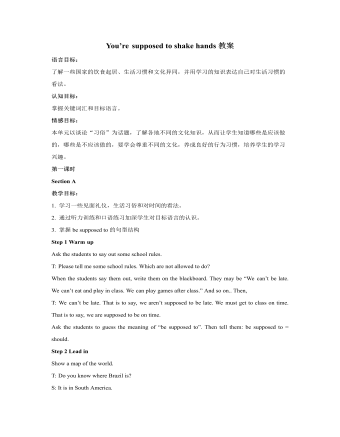
人教版新目标初中英语九年级下册You’re supposed to shake hands教案
- 页数:9页
- |大小:59.50KB
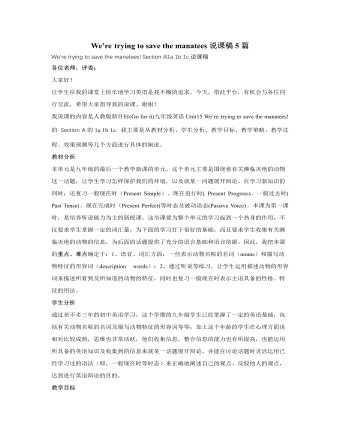
人教版新目标初中英语九年级下册We’re trying to save the manatees说课稿5篇
- 页数:29页
- |大小:154.50KB
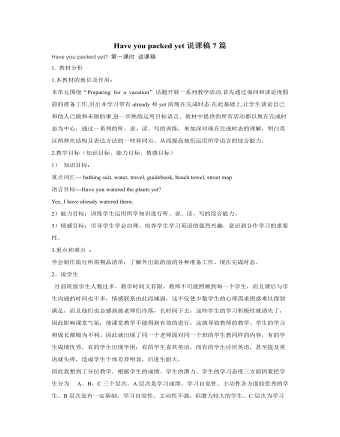
人教版新目标初中英语九年级下册Have you packed yet说课稿7篇
- 页数:41页
- |大小:192.00KB
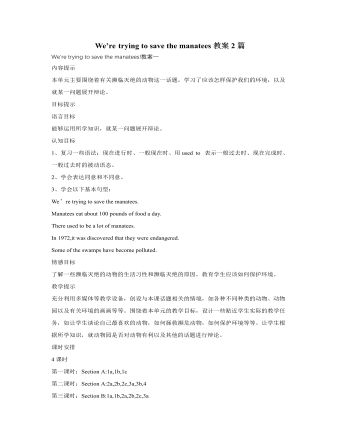
人教版新目标初中英语九年级下册We’re trying to save the manatees教案2篇
- 页数:16页
- |大小:146.50KB
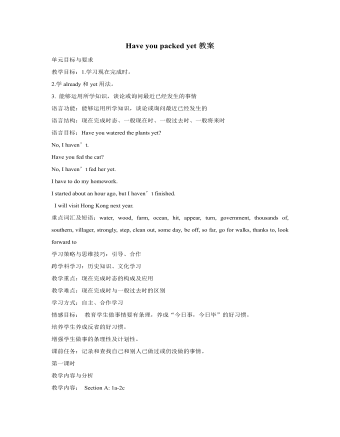
人教版新目标初中英语九年级下册Have you packed yet教案
- 页数:24页
- |大小:103.00KB
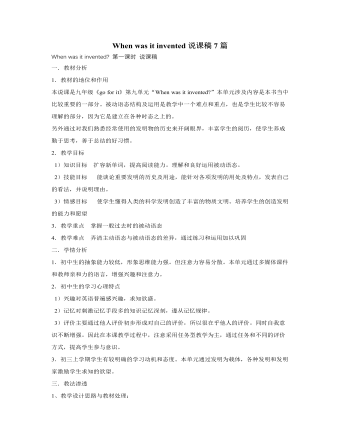
人教版新目标初中英语九年级下册When was it invented说课稿7篇
- 页数:26页
- |大小:113.00KB
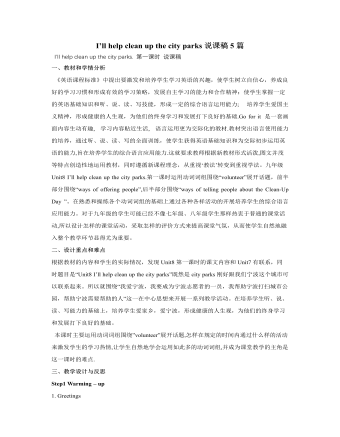
人教版新目标初中英语九年级下册I’ll help clean up the city parks说课稿5篇
- 页数:17页
- |大小:95.50KB
热门说课稿
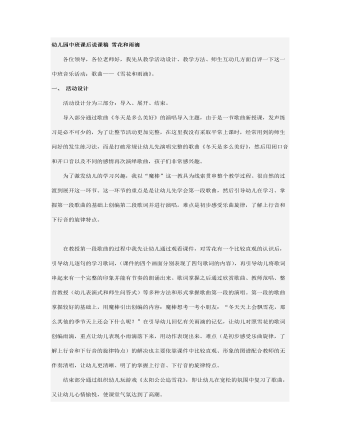
幼儿园中班课后说课稿 雪花和雨滴
- 页数:3页
- |大小:37.00KB
- 说课稿
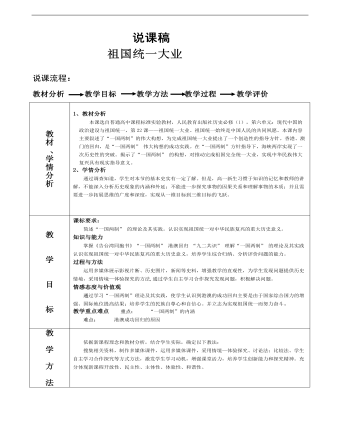
高中历史人教版必修一《第22课祖国统一大业》说课稿
- 页数:3页
- |大小:46.07KB
- 说课稿
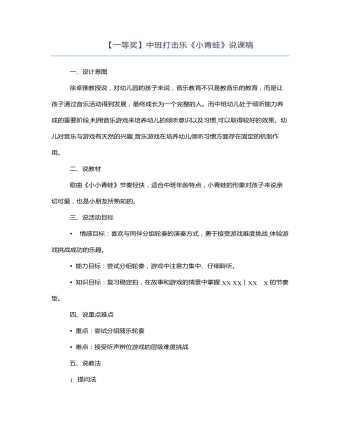
中班打击乐《小青蛙》说课稿
- 页数:4页
- |大小:22.88KB
- 说课稿
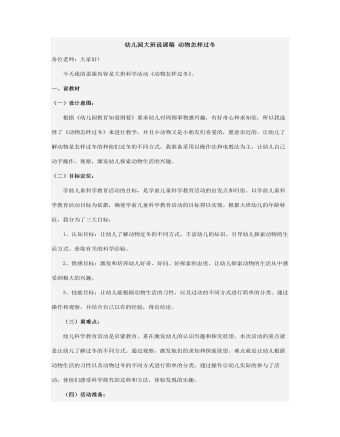
幼儿园大班说课稿 动物怎样过冬
- 页数:3页
- |大小:36.00KB
- 说课稿
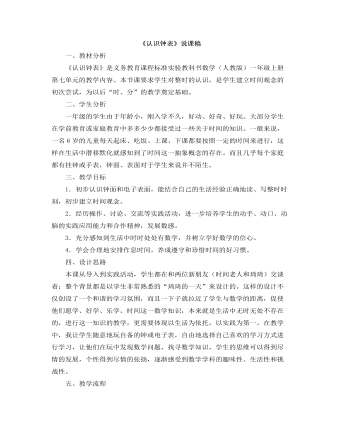
小学数学人教版一年级上册《认识钟表》说课稿
- 页数:4页
- |大小:24.27KB
- 说课稿
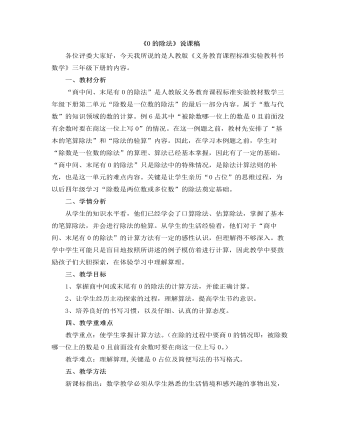
小学数学人教版三年级下册《0的除法》说课稿
- 页数:6页
- |大小:34.92KB
- 说课稿
今日更新

精选高中生期末评语
- 页数:42页
- |大小:7M

××县招商局2024年上半年工作总结
- 页数:12页
- |大小:142.54KB

“四零”承诺服务创建工作总结
- 页数:5页
- |大小:39.83KB
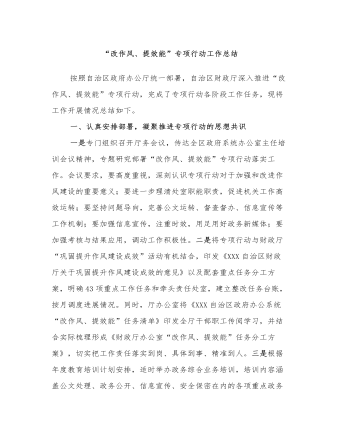
“改作风、提效能”专项行动工作总结
- 页数:6页
- |大小:139.05KB
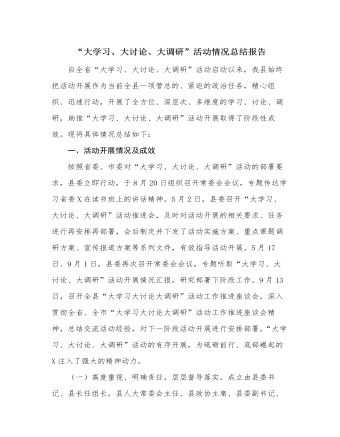
“大学习、大讨论、大调研”活动情况总结报告
- 页数:7页
- |大小:26.12KB
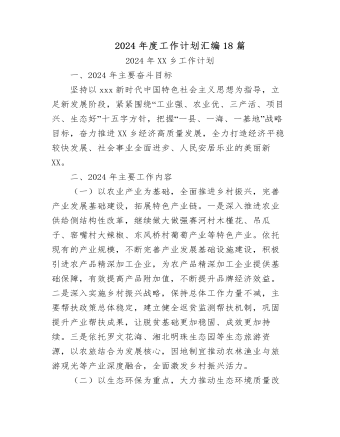
2024年度工作计划汇编(18篇)
- 页数:72页
- |大小:196.93KB





